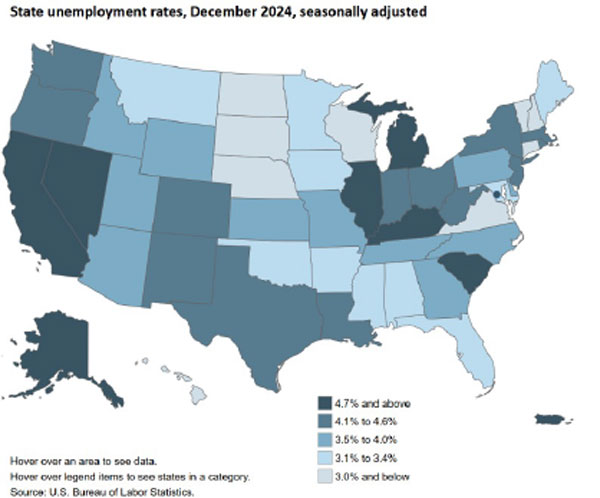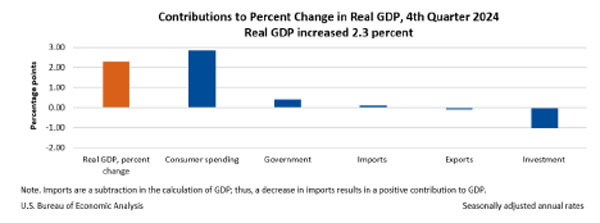EBRC Research Staff
Current data releases as of 31 January 2025
The December monthly Consumer Price Index (CPIU) increased 0.4% after rising 0.3% in November. Energy prices accounted for more than 40% of the monthly all items increase with a rise of 2.6% in December. The index for food increased 0.3% with food at home and food away from home both rising 0.3%. The index of all items less food and energy increased 0.2%, breaking the previous four-month trend of a 0.3% increase per month. The annual inflation rate for December is 2.9%, 0.2 percentage points higher than in November. Core inflation (all items less food and energy) was 3.2% in December. The Phoenix CPI is available on even months, and the December 12-month price change for the metropolitan area was 1.6%. This was 1.3 percentage points lower than the nation. Of the local areas that the U.S. Bureau of Labor Statistics collects data on, the Phoenix metropolitan area had the 2nd lowest increase behind Houston, Texas, which saw a December 12-month price change of 1.0%. – Connor Storie, EBRC Intern
The Producer Price Index rose 0.2% in December on a seasonally-adjusted basis. This rise in final demand can be attributed to a 0.6% increase in final demand goods. Final demand services were unchanged after increasing 0.3% in the last two months. A 3.5% advance in final demand energy is largely responsible for the increase in final demand goods. Final demand goods less foods and energy was unchanged in December. The 12-month unadjusted change in final demand producer prices was 3.3%, up from 3.0% in November. – Connor Storie, EBRC Intern
At 3.8% in December 2024, Arizona’s seasonally-adjusted unemployment rate was significantly below its level one year ago (4.2%) but not significantly different from the national average (4.1%). Twenty-seven states registered over-the-year increases in the unemployment rate, six states posted decreases, and 17 states had little change. The national rate was up 0.3 percentage points from December 2023. South Dakota had the lowest unemployment rate in December at 1.9%. Nevada had the highest at 5.7%. In total, 21 states had unemployment rates significantly below the nation. Five states and the District of Columbia posted rates significantly above the U.S. The largest over-the-year increase occurred in South Carolina and the largest decrease was in Connecticut. -George Hammond

Arizona seasonally-adjusted jobs rose 1.7% over the year in December, outpacing the U.S. at 1.4%. Thirty-three states registered significant over-the-year employment increases, including Arizona. Seventeen states experienced no significant change. Texas generated the most new jobs over-the-year, followed by California and Florida. -George Hammond
U.S. Real GDP grew at an annual rate of 2.3% in the fourth quarter of 2024 based on the advance estimate released by the U.S. Bureau of Economic Analysis. That was slower than the 3.1% increase in the prior quarter. The fourth quarter increase reflected rising consumer and government spending. Those increases were partially offset by a decrease in investment spending, primarily reflecting inventory drawdown. In contrast to the rapid increase in the third quarter of 2024, net exports declined modestly. A second estimate based on more complete source data will be released on February 27th. – Connor Storie, EBRC Intern

In December, Arizona over-the-year building permits saw a notable 30.9% decrease to 3275, not seasonally adjusted. The number of single-family permits similarly decreased, falling 14.7% to 2423. The Phoenix Metropolitan area accounted for most of the permits issued in the state, with 2322, a 35.6% decrease from last December. The number of single-family permits similarly fell 21.1% to 1653. The Tucson MSA similarly observed over-the-year declines, with the number of total permits falling 40.0% to 307, and the number of single-family permits declining 10.5% to 256. Of the counties, Apache, Coconino, Gila, La Paz, Navajo, and Santa Cruz saw increases, while Cochise, Graham, Maricopa, Mohave, Pima, Pinal, Yavapai, and Yuma saw decreases. No changes were observed in Greenlee. -Delaney O’Kray-Murphy
In the final quarter of 2024, Phoenix experienced a 2.8% year-over-year rise in the Employment Cost Index (ECI) for private industry workers. This marks a slowdown compared to the previous quarter’s 3.3% annual increase and a sharper decline from the 4.1% annual rise seen in the fourth quarter of 2023. Nationally, private industry compensation grew at an annual rate of 3.6% during the same period, putting Phoenix’s ECI below the national average. The San Jose-San Francisco-Oakland, CA combined statistical area recorded the highest increase in total compensation at 6.3% while the Miami-Fort Lauderdale-Port St. Lucie, FL area saw the smallest change, with a 2.5% annual rate. -Delaney O’Kray-Murphy
Phoenix house prices moved little in November, increasing 1.6% on a year-to-year basis. Nationally, house prices increased 3.8% over-the-year in November based on the S&P CoreLogic Case-Shiller Indices. The 20-city composite saw an annual increase of 4.3%, slightly lower than last month’s over the year figure of 4.6%. Phoenix and National home prices observed an increase in their over-the-year figures in November, reflecting lower base effects. The 10-city composite saw an annual increase of 4.9%, recording the same annual increase as the previous month. New York again reported the highest annual gain among the 20 cities with a 7.3% increase in November, Followed by Chicago and Washington with annual increases of 6.2% and 5.9%, respectively. Tampa posted the lowest return, falling 0.4%. -Delaney O’Kray-Murphy
According to the January 17th State Job Openings and Labor Turnover (JOLTS) report, the job openings rate decreased in two states, increased in two states, and was little changed in all other states. The job openings rates for Arizona were 5.5% in November, 5.0% in October, and 5.2% in September. The number of job openings decreased in two states, increased in three states, and was little changed in all other states.
The largest decreases in the number of job openings were seen in Colorado (-92,000) and Maine (-7,000). The largest increase was seen in California (+98,000). Hire rates decreased in six states, increased in one state, and little changed in all other states. The hire rates for Arizona were 3.5% for November, 3.3% for October, and 3.7% for September. The number of hires decreased in six states and changed little in all others. The largest decreases in hire levels were in Texas (-128,000) and Tennessee (-27,000). The number of layoffs and discharges decreased in three states, increased in three states, and was little changed in all other states. Nationally, the layoffs and discharge rates were little changed. –Alex Jaeger





